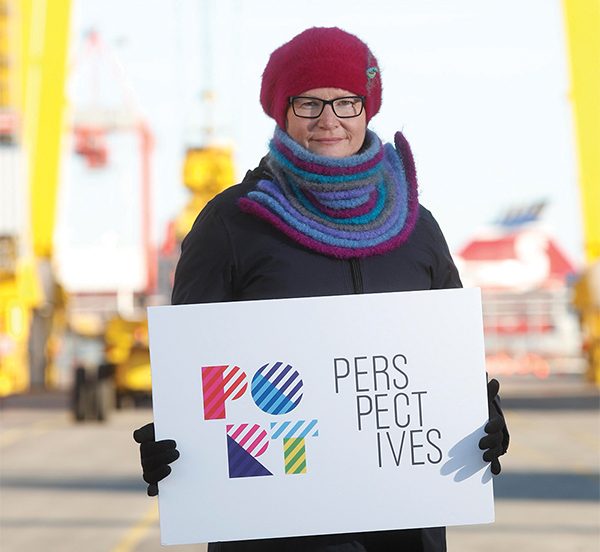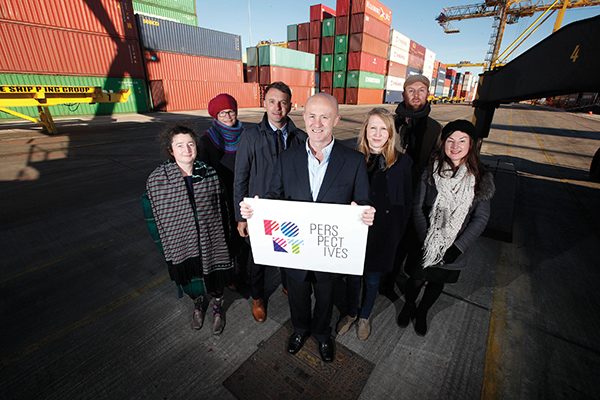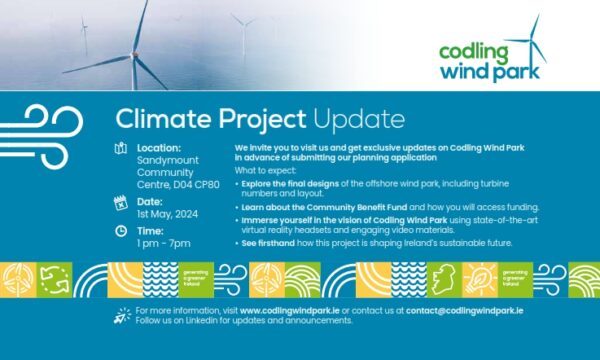
Pictured: Sheelagh Broderick.
Conor McCabe Photography
Port Walks is an art project by Sheelagh Broderick and commissioned by Dublin Port. Sheelagh is a former journalist and town planner. The aim of Port Walks is to bring together the people who use the area recreationally and those who work there. NewsFour asked Sheelagh about her time creating the project.
Tell us about your background and how you became involved in the project?
I am an artist. My artwork is developed through processes of social engagement using the materials, practices and spaces of everyday life. When Dublin Port advertised the Port Perspectives Commission, my mind immediately turned to the seafarers who enter and leave Dublin Port and to the people who walk on the Great South Wall. Their paths seem so close and yet so distant. Ships entering and leaving Dublin Port can pass within 50 metres of the Poolbeg lighthouse, yet the walkers on the wall have little understanding of a seafarer’s life. I decided to submit a proposal that would address this apparent proximity and this distance by producing podcasts about shipping and seafarer lives. Walking the Great South Wall is in a way like going to sea, the wall arches out 2km from shore as far as Poolbeg lighthouse and is almost equidistant between Howth and Dun Laoghaire.
What can the average person learn from the Port Walks series?
The first podcast details how containers changed everything for seafarers and how globalisation has changed the crewing of ships. It takes a particular interest in the Philippines which supplies almost one quarter of all seafarers worldwide. The second podcast explores Flags of Convenience and consequent measures taken to address standards. It also considers life at sea in the age of the internet. The third podcast turns to the walkers on the Great South Wall for their views on contemporary shipping and then is followed by speculation about the future, about autonomous vessels that will undertake long sea voyages without having any crew onboard. In a way you could say that the podcasts deal with the past, present and future of seafaring, but you can listen to them in any order. So far I have yet to meet someone who has not learned something from listening to the podcasts.

Pictured (l-r) at Dublin Port are the first Port Perspectives artists commissioned to create public artworks, Cliona Harmey, Sheelagh Broderick, Business to Arts CEO Andrew Hetherington, Dublin Port CEO Eamonn O’Reilly, Alice Butler, Daniel Fitzpatrick, Silvia Loeffler.
I set about meeting seafarers by setting up a recording studio at the seafarer centre on Alexandra Road in Dublin Port. I met mostly Filipino, Ukrainian and Indian seafarers.They had roles as diverse as being a captain to being a dancer on a cruise ship. The Flying Angel Mission to Seafarers were an anchor partner. Rev. Willie Black, Noeleen Hogan, Dermot Desmond and a great team of volunteers provide a great service there seven days and nights a week. I was also greatly assisted by Rose Kearney of Stella Maris Apostleship to the Sea who also is a volunteer at the seafarer centre and Michael Whelan of the International Transport Federation, who works in Dublin Port as an ITF inspector.
The staff in Dublin Port were wonderful too and were so helpful in responding to my many requests. The two other commissioned artists Silvia Loeffler and Cliona Harmey were a great support, as was Declan McGonagle who manages the parallel programme of public engagements and Margarita Vasquez Cardenas of Business to Arts who acted as project managers. I was very fortunate to make contact with musicians and composers. Linda Buckley, Chumbawamba, Susan Stenger and Andria Degens, Cliona Harmey, Ewa Gigon, and Raymond Deane were very generous in allowing me to use their work. Dan Guiney was sound engineer for all the podcasts and did a great mix.
How important do you think the port is to the local community?
During a tour of Dublin Port organised on International Seafarers Day, Jerry Sheehan of SIPTU described the port as the beating heart of the city. I would add to that and say that Dublin Port is the beating heart of the country. Without Dublin Port and the seafarers that bring ships carrying over 90% of tradeable goods, we might starve or freeze. To walkers on the Great South Wall they are a key attraction for walking on the wall. People watch ships and know their movements in and out of the port. They take a great interest in the cruise liners that stand so high above sea level, dominating all around them. One cruise ship had to turn out in the bay and enter the port astern (that’s in reverse). Now that must have been quite a sight.
And finally! What is the best way to experience your podcasts?
You can listen from anywhere by downloading Port Walks podcasts from iTunes, Soundcloud and on any of the Android podcast apps like Podcasts Addict or Stitcher. I recommend you listen as you take a walk on the Great South Wall. Instructions on how to get there are on the website: www.portwalks.ie. If you can’t manage Podcast technology you can listen from the audio player on the website portwalks.ie/podcasts in the comfort of your own home on your laptop or desktop computer. So whether you are technologically adept or not there is a way to listen in.
By Jessica Ellis



